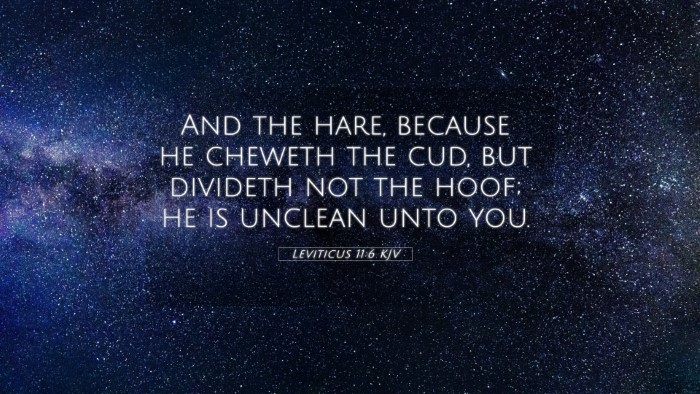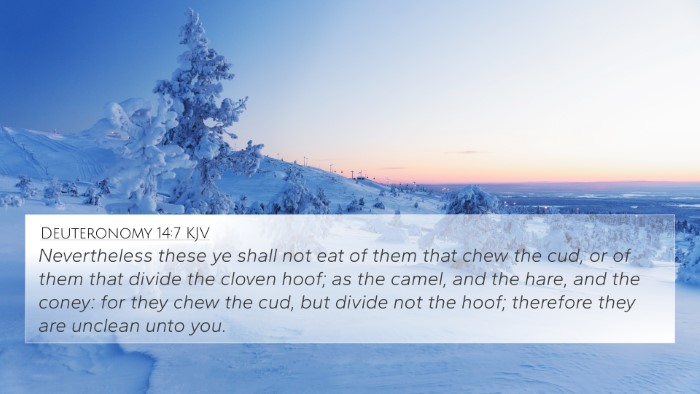Understanding Leviticus 11:6
Bible Verse: Leviticus 11:6 - "And the hare, because it cheweth the cud, but divideth not the hoof; it is unclean unto you."
Summary of Meaning
The verse from Leviticus 11:6 addresses dietary laws, specifically concerning the hare. This verse serves as a significant teaching within the Jewish laws regarding clean and unclean animals. The insights drawn from public domain commentaries shed light on the symbolic and practical aspects of this command.
Commentary Insights
-
Matthew Henry:
Henry emphasizes that the hare is included among the unclean animals, illustrating the importance of divine instruction in matters of diet. He notes the distinction made between animals that both chew the cud and have divided hooves as criteria for cleanliness, indicating God's intent to separate His people from worldly practices.
-
Albert Barnes:
Barnes highlights the hare's characteristics, drawing attention to its habit of chewing cud, but lacking the physical signs of being clean (a divided hoof). He suggests that these laws serve as a metaphor for spiritual cleanliness, emphasizing the need for internal purity to align with external practices.
-
Adam Clarke:
Clarke provides additional context about the hare, indicating that despite its cud-chewing, it does not fit the criteria of a clean animal in the Jewish tradition. He discusses the spiritual symbolism behind dietary restrictions and their role in maintaining holiness among God’s people.
Thematic Connections
The dietary laws, as seen in Leviticus 11:6, can be connected thematically across various scripture, leading to reflections on purity, devotion, and divine separation.
Cross-Referencing Related Bible Verses
- Deuteronomy 14:7-8: Discusses other unclean animals, reinforcing the principle established in Leviticus.
- Isaiah 66:17: Connects unclean practices with the judgment of God in prophetic literature.
- Mark 7:19: Illustrates the New Testament perspective on dietary laws through Jesus’ teachings about what truly defiles a person.
- Acts 10:14-15: Shows the shift in dietary restrictions in the early church, highlighting God’s inclusive plan.
- 1 Corinthians 10:23-31: Discusses the principle of freedom and the conscience regarding dietary matters.
- Hebrews 9:10: Explains the temporary nature of these laws in light of the new covenant.
- Romans 14:14: Paul’s teaching on the understanding of clean and unclean foods in the Christian community.
Application and Interpretation
Understanding Leviticus 11:6 requires grappling with both the historical context and its theological implications. The laws emphasize divine authority and the call for holiness, reflected through dietary restrictions. The insights from commentaries encourage believers to observe the original intention behind these laws, focusing on the inner transformation rather than mere external adherence.
Tools for Further Study
For those interested in deeper exploration, several tools can aid in cross-referencing Bible verses effectively:
- Bible Concordance: Use this tool to find specific verses and their occurrences throughout the Bible.
- Bible Cross-Reference Guide: A helpful resource for navigating connections between different scripture passages.
- Bible Reference Resources: Implement these resources for comprehensive studies on themes and verses.
- Cross-Reference Bible Study Methods: Engage in methods that allow for thematic exploration of verses and topics.
- Inter-Biblical Dialogue: Study the connections between Old and New Testament texts to reveal overarching biblical themes.
Conclusion
Leviticus 11:6 serves not only as a historical command but also as a spiritual lesson on holiness, cleanliness, and our relationship with God's decrees. As readers and believers, exploring this verse in light of surrounding scripture enhances our understanding of Biblical principles guiding moral and ethical decisions throughout our lives. By employing the mentioned tools and understanding thematic links, one can uncover the rich texture of scripture that offers insight and revelation.



